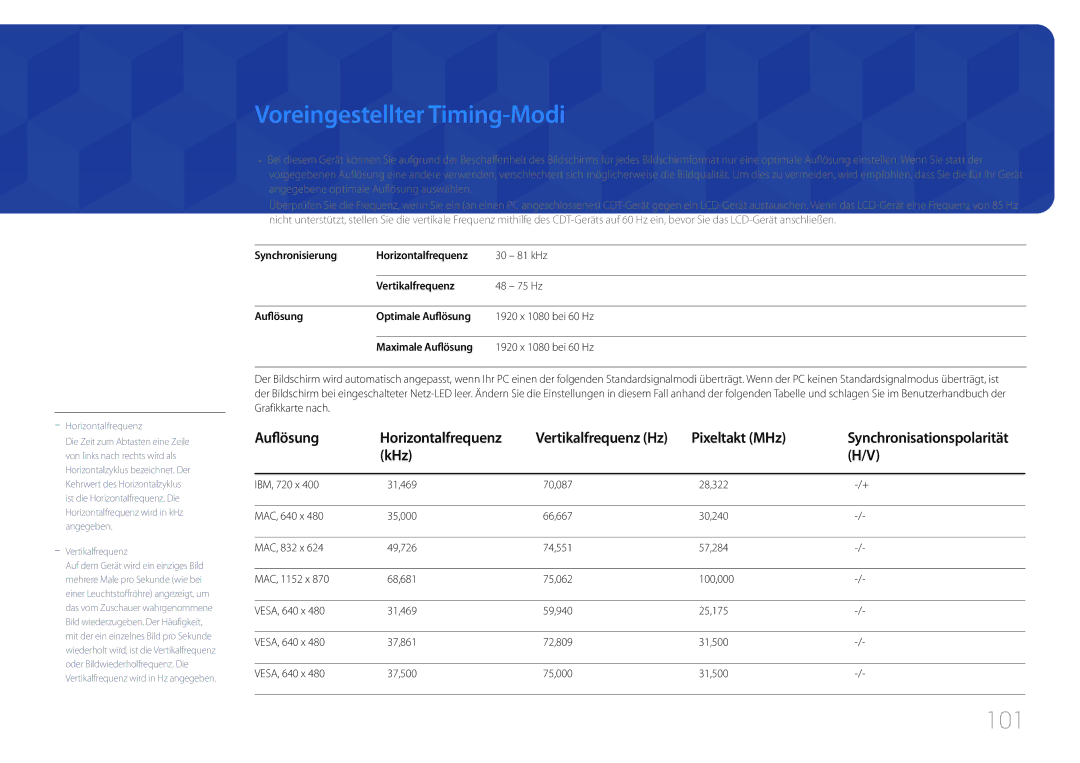Benutzerhandbuch
Inhaltsverzeichnis
Anpassen des Tons
Unterstützung
Copyright
Vor Inbetriebnahme des Geräts
Sicherheitshinweise
Symbole
Reinigung
Vorsicht
Strom und Sicherheit
Aufbewahrung
Installieren
Samsung
Betrieb
Stecken Sie keine metallischen Gegenstände Schrauben, Münzen
Stellen Sie keine schweren Gegenstände auf das Gerät
Verursachen
Überprüfen des Lieferumfangs
Vorbereitung
Komponenten
Kurzanleitung zur Konfiguration Garantiekarte SUB-Kabel S
Wandhalterung HDMI-Kabel S HDMI-DVI-Kabel S
Separat erhältliche Teile
TastenBeschreibung
Bauteile
Steuerungstaste
Anschluss Beschreibung
Rückseite
Tasten Beschreibung
Externes Sensorkit
Anbringen des externen Sensorkits an der Seite
Werden
Montieren des Standfußes mit Kabelhalter
Einschalten des Geräts
Fernbedienung
Schnellzugriff auf häufig verwendete Funktionen
So legen Sie die Batterien in die Fernbedienung ein
Wechseln Sie zurück zum vorherigen Menü
Manuelle Auswahl der Eingangsquelle PC, DVI
Lüftung
Zwischen Hoch- und Querformat wechseln
Montage an einer senkrechten Wand
Abbildung 1.1 Ansicht von der Seite
Montage an einer unregelmäßigen Wandfläche
Abmessungen
Draufsicht
Modellname
Montieren des Wandhalterungskits
Montieren der Wandhalterung
Standardschraube
Spezifikationen des Wandhalterungskits Vesa
Fernbedienung RS232C
Stift Signal
Kabelanschluss
RS232C-Kabel
RS232C-Kabel Anschluss D-Sub 9-polig-auf-Stereo-Kabel
Anschluss
Dose
Gnd
Anzeigen des Steuerstatus Befehl Get control
Steuercodes
Steuerung Befehl Set control
Befehl
Einstellen der Lautstärke Set Volume
Ein-/Ausschalten der Stromversorgung Set Power on / OFF
Steuerung Stromversorgung
Steuerung Lautstärke
Steuerung Eingangsquelle
Einstellen der Signalquelle Set Input Source
Steuerung Bildschirmmodus
Anzeigen des Bildschirmstatus Get Screen Mode Status
Steuerung der Bildschirmgröße
Einsellen des Bildformats Set Picture Size
Steuerung PIP Ein/Aus
Auto Adjustment 0x00 immer Bestätigung
Steuerung Automatische Einstellung nur PC und BNC
Aktivieren/Deaktiviern des PIP-Modus Set PIP on / OFF
Vollbild Natürlich
Steuerung des Videowandmodus
Sicherheitsverriegelung
Videowand-Benutzersteuerung
Videowand EIN
Aus
10x10-Videowandmodell
WallSNo Am Gerät einzustellender Produktnummer-Code
10x10-Videowandmodell 1 ~
Nummer einstellen Daten
0x01 0x02 0x63
Vor dem Anschließen
Anschließen und Verwenden eines externen Geräts
Anschließen an einen PC
Vorbereitungen vor dem Anschließen
Anschließen mit einem HDMI-DVI-Kabel
Anschließen mit einem DVI-Kabel digital
Anschließen mit einem HDMI-Kabel
Anschließen mit einem AV-Kabel
Anschließen an ein Videogerät
Anschließen mit dem Component-Kabel
Sie können das Videogerät über ein Kabel anschließen
Verbinden, das keinen HDMI-Ausgang hat
Verbinden über ein HDMI-Kabel
Mit einem HDMI-Kabel oder HDMI-DVI-Kabel bis zu 1080p
Ändern der Eingangsquelle
Anschließen an ein Audiosystem
Quelle
Quelle
Konfigurieren der Einstellungen für Multi Control
Verwenden von MDC
Konfigurieren der Einstellungen fürMulti Control
Deinstallieren
Installieren und Deinstallieren des Programms MDC
Klicken Sie auf das MDC Unified-Installationsprogramm
Der Fortschritt des Installationsprozesses wird angezeigt
Verbinden mit MDC
Bildmodus
Bildschirmanpassung
Die Eingangsquelle ist PC, DVI, Hdmipc
Die Eingangsquelle ist AV, Component, Hdmiav
Menu m Bild Enter
Eingangsquelle Bildmodus Anpassbare Optionen
Bildformat
Bildformat
Bildformat
· Position Auflösung wählen
Eingangsquelle Bildformat
Je nach Eingangsquelle verfügbare Bildformate
Zoom/Position
Position
Bildformat 169
BildformatBenutzerdef
Auflösung wählen
Autom. Einstellung
Bildformat 169 · Position
Menu m Bild Autom. Einstellung Enter
Fein Position Bild zurücksetzen
PC-Bildschirmanpassung
PC-Bildschirmanpassung
Bild des ersten Tuners Bild des zweiten Tuners
PIP Einstellungen
Menu m System PIP Enter
Component
Optimalkontrast
Erweiterte Einstellungen
Schwarzton
Hautton
Weißabgleich
Farbraum
Gamma
Bewegungsbel
Bildoptionen
Bildoptionen
Eingangsquelle Bildmodus Bildoptionen
Menu m Bild Bildoptionen Enter
Farbtemp
Farbton
Digital aufbereiten
MPEG-Rauschfilter
Auto Motion Plus nur Modell ED75D
Filmmodus
Dynam. Hintergrundbel
Auto Motion Plus Aus Dynam. Hintergrundbel
Bild aus
Bild aus
Bild zurücksetzen
Tonmodus
Anpassen des Tons
Ton
Soundeffekt Lautsprechereinstellungen Ton zurücks
Lautsprechereinstellungen Ton zurücks
Soundeffekt
TonmodusStandard
Ton zurücks
Lautsprechereinstellungen
TonmodusStandard Soundeffekt
TonmodusStandard Soundeffekt Lautsprechereinstellungen
Quellen
Anwendungen
Aktual
Name bearb
Menüsprache
System
System
Multi Control Zeit Öko-Lösung Einbrennschutz Ticker
Zeit Öko-Lösung Einbrennschutz Ticker
Multi Control
MenüspracheDeutsch
Sleep-Timer
Sleep-Timer
Zeit
Zeit einstellen
Autom. Ein 1 ~ Autom. Ein
Autom. Ein
Autom. Aus Feiertagsverwaltung
Autom. Ein
Autom. Aus
Feiertagsverwaltung
Energiesparmod
Öko-Lösung
Öko-Sensor
Autom. Aussch
Einbrennschutz
Timer Aus Sofort darstellen Seite grau
Pixel-Shift
Einbrennschutz
Sofort darstellen Aus Seite grau
Timer
Pixel-Shift Aus
Sofort darstellen
Pixel-Shift Aus Timer
Seite grau
Seite grau Aus
Videowand Einstell. für autom. Quelle
Ticker
Menu m System Ticker Enter
Vertikal Auf / Mittel / Ab
Videowand
Videowand
Format
Horizontal
Videowand Ein · Format Vollbild · Horizontal
Vertikal
Bildschirmposition
Autom. Quellenwahl
Einstell. für autom. Quelle
Primärquellenauswahl
Primärquelle
Menu m System PIN ändern Enter
PIN ändern
Max. Energiesparen
Allgemein
Spielemodus
Sicherheitssperre
Standby-Steuerung
Tastensperre
Lampenzeitplan
Max. Energiesparen Ein Spielemodus
Anschaltkorrektur
OSD-Anzeige
Temperatursteuerung
Anschaltkorrektur
Anynet+ HDMI-CEC
Anynet+ HDMI-CEC
Anynet+ HDMI-CEC
Anynet+ Menü
Umschalten zwischen Anynet+-Geräten
Autom. Ausschalten
Anynet+ HDMI-CEC
Nein / Ja
Fehlerbehebung für Anynet+
Problem Mögliche Lösung
Anynet+ funktioniert nicht
Ich möchte Anynet+ starten
Das verbundene Gerät wird nicht angezeigt
Problem
System zurücksetzen
Magic Clone
Magic Clone
Von USB klonen
Menu m System Alle zurücksetzen Enter
Alle zurücksetzen
Menu m Unterstützung Software-Update Enter
Software-Update
Unterstützung
Samsung kontaktieren
Überprüfen von Auflösung und Frequenz
Handbuch zur Fehlerbehebung
Testen des Geräts
Bildschirmproblem
Installationsproblem PC-Modus
Überprüfen Sie folgenden Punkte
Mod non ottimale wird angezeigt
Passen Sie Helligkeit und Kontrast an
Schärfe an
Tonproblem
Man hört noch etwas, wenn die Lautstärke stumm
Video ist zu sehen, jedoch ist nichts zu hören
Geschaltet ist
Geändert wird
Probleme mit dem Anzeigegerät
Probleme mit der Fernbedienung
Beim Starten des PCs ertönt ein Signalton
Die Fernbedienung funktioniert nicht
Das Menü PIP ist nicht verfügbar
Andere Probleme
Wenn ich die PC-Auflösung ändere, wird die Meldung
HDMI-Schwarzp.funktioniert an einem HDMI-Gerät mit
Der IR-Sensor funktioniert nicht
Frage Antwort
FAQs
Wie kann ich die Frequenz ändern?
Monitoreinstellungen an
Wie stelle ich den Energiesparmodus ein?
Frage
Technische Daten
Page
100
Energiesparmodus
Energiesparmodus Normaler Betrieb Ausschalten
Netztaster aus
101
Voreingestellter Timing-Modi
Auflösung Horizontalfrequenz
Pixeltakt MHz
102
Kontakt zu Samsung
Anhang
103
Samsung
104
Europe
105
106
107
0800
108
852 3698
109
110
111
Andere
112
Kein Produktdefekt
113
Ordnungsgemäße Entsorgung
Korrekte Entsorgung der Batterien dieses Produkts
Gilt für Länder mit Abfalltrennsystemen
Optimale Bildqualität
114
Vermeidung des Einbrennens von Nachbildern
Was geschieht beim Einbrennen von Nachbildern?
Time
115
116
Lizenz
117
Terminologie

